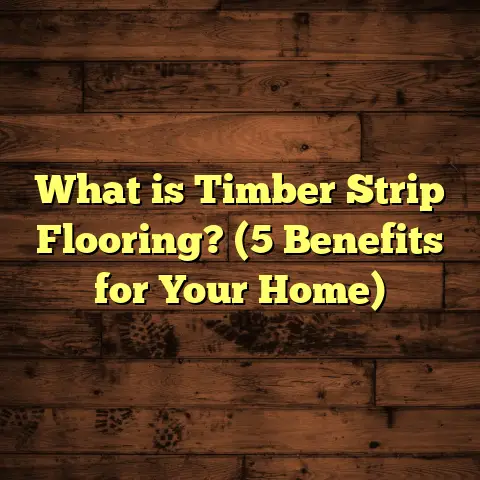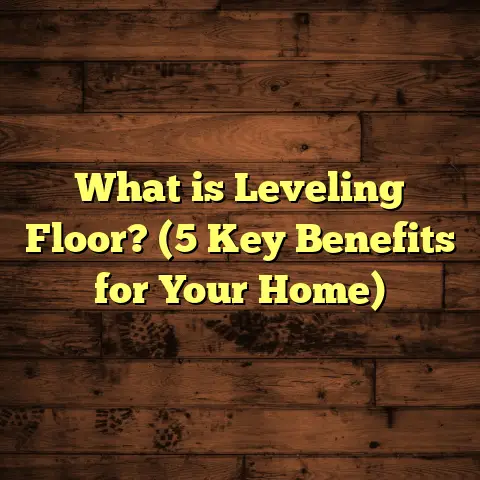What is a Linear Foot in Vinyl Sheet Flooring? (5 Essential Facts)
I always start my flooring projects by thinking about what’s best for pets. Vinyl sheet flooring is a favorite among pet owners I work with because it’s durable, easy to clean, and gentle on paws. When you have dogs or cats, floors take a real beating — scratches, spills, accidents — and not every flooring type holds up well. Vinyl sheets handle all that better than most.
But here’s something I’ve noticed over the years: many people get confused when it comes to measuring and buying vinyl sheet flooring. One term that trips up even experienced DIYers is the “linear foot.” You might hear someone say, “We need 50 linear feet of vinyl,” and wonder what that really means. How does linear foot relate to vinyl sheets? Why is it so important? And how does it affect your budget and installation planning?
I’ll walk you through everything I’ve learned about linear feet in vinyl sheet flooring — from definitions to personal stories, to data-backed tips — so you can feel confident in your next flooring project.
What Is a Linear Foot in Vinyl Sheet Flooring?
Let me start with the basics: what exactly does “linear foot” mean?
A linear foot is a way of measuring length. It’s simply one foot long — no matter what the width or thickness is. When talking about vinyl sheet flooring, which usually comes in large rolls, the linear foot refers to how long a piece of flooring is cut from the roll.
Imagine you’re looking at a giant roll of vinyl that’s 6 feet wide. If you buy 10 linear feet, that means you get a piece that is 6 feet wide (the roll width) and 10 feet long.
So:
- Linear foot = 1 foot of length
- Width depends on the roll (usually between 6 and 12 feet wide)
- Vinyl sheet flooring is sold by the linear foot because length varies depending on your purchase; width stays fixed
This is different from square footage, which measures area (length × width). Vinyl sheet flooring pricing normally uses linear feet because rolls come in fixed widths but variable lengths.
Why do manufacturers use linear feet for vinyl sheets?
It’s mainly practical. Vinyl sheet flooring rolls are made in standard widths—often 6, 7, or 12 feet wide. You don’t buy an entire roll at once but instead order the length you need.
If pricing were based on square footage alone, customers might not get enough material to cover their room because of how the rolls are cut. Linear foot pricing simplifies ordering by focusing on how much length you want.
How does this affect you as a buyer?
Well, understanding linear feet helps you estimate material needs better. Instead of guessing how many rolls or pieces you need based on square footage alone, you can calculate how many linear feet will cover your space efficiently.
Why Linear Foot Matters for Vinyl Sheet Flooring
Let me tell you a story from early in my career. I was helping a client pick vinyl for their kitchen and living room. They measured the room’s square footage and told me they wanted enough vinyl for that area.
I ordered enough vinyl based on square footage but didn’t account for the roll width and how many strips we’d need to cover the room width. When the delivery came, there wasn’t enough length on the roll for two strips side by side because the roll was only 6 feet wide and the room was wider than that.
We had to rush-order more material, which cost extra and delayed the job.
That experience taught me: You can’t just think about square feet when buying vinyl sheets — you have to understand linear feet and roll width together.
Here’s why linear foot matters:
- Vinyl sheets come in fixed widths but variable lengths
You can’t change the width of the roll. So if your room is wider than the roll, you’ll need multiple strips laid side by side. - Length is cut to order
You tell suppliers how many linear feet you want, and they cut the roll accordingly. - Pricing depends on length (linear feet)
Buying more length costs more money, so accurate measurement avoids overspending or shortages.
Calculating material needs with linear feet
Say your room is 10 feet wide and 15 feet long:
- Your vinyl roll is 6 feet wide.
- To cover 10 feet width, you need two strips side by side (because one strip covers only 6 feet; 2 strips = 12 feet total width).
- Each strip must be at least 15 feet long.
- Total linear feet = 2 strips × 15 ft length = 30 linear feet.
If you misunderstood and just bought 15 linear feet because that was the room length, you’d be short by half your material!
How I Calculate Vinyl Sheet Flooring Using Linear Feet
When I take on a project involving vinyl sheets, here’s my step-by-step process:
Step 1: Measure your room precisely
Get accurate measurements for both length and width. Don’t rely on rough guesses. Use a tape measure or laser distance measurer to get exact numbers.
Step 2: Know your vinyl roll width
Vinyl rolls come in several standard widths:
| Roll Width Options | Common Sizes (feet) |
|---|---|
| Narrow | 6 |
| Medium | 7 to 8 |
| Wide | 12 |
Always check product specs or ask your supplier for exact width.
Step 3: Calculate how many strips are needed
Divide the room width by roll width: Number of strips=Room WidthRoll Width\text{Number of strips} = \frac{\text{Room Width}}{\text{Roll Width}}
Round up since partial strips aren’t possible.
Step 4: Multiply strips by room length
Multiply that number of strips by room length to get total linear feet needed: Linear Feet=Number of strips×Room Length\text{Linear Feet} = \text{Number of strips} \times \text{Room Length}
Step 5: Add waste factor
Add about 5-10% extra for mistakes, pattern matching, or cutting around obstacles like doorways or corners.
Example from my recent project
A kitchen measured 12 ft wide by 20 ft long. The vinyl roll was 6 ft wide.
- Number of strips: 12/6=212 / 6 = 2
- Linear footage: 2×20=402 \times 20 = 40 ft
- Waste factor (10%): 40×0.10=440 \times 0.10 = 4 ft
- Total ordered: 40+4=4440 + 4 = 44 linear feet
This method has never failed me for accurate orders and minimal waste.
Real Data and Costs: What Linear Foot Means for Your Budget
Pricing varies depending on quality, brand, location, and installation method. Here’s a rough guide based on data from projects I’ve done over time:
| Vinyl Type | Cost Per Linear Foot* (6 ft roll width) | Cost Per Square Foot Estimate* |
|---|---|---|
| Basic Sheet Vinyl | $4 – $6 | $0.67 – $1 |
| Mid-Range Vinyl | $6 – $10 | $1 – $1.67 |
| Luxury Vinyl Sheet | $10 – $15 | $1.67 – $2.50 |
*Prices exclude installation labor costs.
Because pricing is per linear foot, knowing your exact linear footage helps estimate materials precisely. For example:
If your room requires 50 linear feet of mid-range vinyl on a 6-foot-wide roll, your material cost will be roughly: 50 linear ft×$8 per linear ft=$40050 \text{ linear ft} \times \$8 \text{ per linear ft} = \$400
Add labor and other supplies for total cost.
How FloorTally Helps Me With These Calculations
In my work, I use FloorTally — an online tool that simplifies calculating linear footage and total costs based on local rates.
I plug in:
- Room dimensions
- Roll width
- Vinyl type
- Waste percentage
FloorTally instantly gives me:
- Required linear footage
- Estimated material cost
- Local labor cost estimates
- Total project budget
This saves hours of back-and-forth with suppliers and lets me give clients accurate prices upfront without surprises.
Case Study: Installing Vinyl Flooring for a Pet-Friendly Home
One of my favorite projects was with a family who had two large dogs and wanted floors that could handle wear and tear but still feel comfortable underfoot.
We selected a tough luxury vinyl sheet with extra thickness (5 mm) for durability and softness. The roll was 7 ft wide and priced at about $8 per linear foot.
The living room was an odd shape — roughly a rectangle measuring 14 ft wide by 22 ft long plus an adjacent nook about 3 ft in length.
Calculations went like this:
- Number of strips: 14/7=214 / 7 = 2
- Total length including nook: 22+3=2522 + 3 = 25 ft
- Total linear footage: 2×25=502 \times 25 = 50 linear feet
- Add waste factor (10%): 50+5=5550 + 5 = 55 linear feet ordered
The installation went smoothly because we had enough material upfront—no waiting for reorder deliveries. The dogs adapted well too; their paws didn’t slip on the textured surface, and cleanup after muddy days was easy with just a mop wipe.
The family also appreciated knowing exactly what they were paying for — no guesswork or hidden costs since FloorTally helped us manage budgeting.
Why Linear Foot Measurement Beats Square Footage Pricing for Vinyl Sheets
You might wonder: why don’t suppliers just sell vinyl sheets by square foot like carpet or tile?
Vinyl sheet flooring rolls complicate that because they come in fixed widths but variable lengths cut to order. Here are some reasons why linear foot pricing works better:
- Simplifies ordering
You pick how long (linear feet) you want from a known roll width. - Reduces waste
Buying in square footage without considering roll width can mean awkward leftover pieces or shortages. - Reflects real usage
Since installation involves laying strips based on roll width, linear footage matches actual material required more closely.
More Insights From My Experience With Linear Feet
Over time, I’ve picked up some useful habits related to measuring and ordering vinyl floors using linear feet:
Always confirm roll width before ordering
Sometimes suppliers list similar products but with different widths (e.g., both 6 ft and 12 ft rolls available). Confirming helps avoid wrong orders.
Measure rooms yourself twice
Even if clients provide measurements, I double-check everything onsite before placing an order. It saves headaches later.
Break complex rooms into sections
If your space has closets, nooks, or odd angles, divide it into rectangles. Calculate linear feet for each section separately then add them up.
This reduces errors and ensures you have enough material for tricky spots.
Communicate clearly with installers
Make sure everyone understands what “linear foot” means so no assumptions cause material shortages or excess waste on installation day.
What About Waste Factor? How Much Extra Should You Order?
Cutting vinyl sheets neatly around corners, doorways, vents or matching patterns always creates some waste. I usually recommend adding about 5-10% extra material as a buffer.
For rooms with complex shapes or heavy pattern matching requirements (like wood grain alignment), closer to 10% waste factor is safer.
For simple rectangular rooms without patterns, 5% might be enough.
Ordering too little means delays waiting for more material; too much means extra cost but easier installation flow. I’d rather have a little leftover than run short mid-project.
What Exactly Does Vinyl Sheet Flooring Look Like?
If you’re new to vinyl sheets, they typically come rolled up like giant wallpaper tubes. Thickness varies but usually ranges from about 2 mm (thin) to 5 mm (luxury thick).
Common widths are usually 6, 7, or 12 feet wide rolls. You cut strips from these rolls based on room size measured in linear feet — which brings us right back to why understanding this measurement matters so much!
The surface can mimic wood grain, stone textures, or solid colors depending on style chosen — making it very versatile in design options too.
How Do Installation Techniques Tie Into Linear Feet?
Installation methods for vinyl sheet flooring depend partly on how much material you have and its layout in strips:
- You lay down adhesive or use click-lock systems depending on product.
- Strips from rolls are unrolled lengthwise across rooms.
- Seams where strips meet require careful cutting and sealing.
Knowing exactly how many linear feet you have helps installers plan seams and cuts efficiently without scrambling last minute for extra pieces.
Vinyl Sheet Flooring vs Other Flooring Types: Why Linear Foot Measurement Stands Out
Comparing vinyl sheet flooring with tile or hardwood reveals why its measurement method differs:
- Tile flooring sold by square foot since tiles are fixed-size units.
- Hardwood planks sold by board foot or square foot.
- Vinyl planks often sold by square foot.
- But vinyl sheets sold by linear foot due to roll format with fixed widths but variable lengths.
This sometimes confuses new homeowners expecting all flooring types priced similarly. Understanding this helps avoid surprises when budgeting or shopping around.
How Pets Influence Flooring Choice—and Why Vinyl Sheets Matter Here
Let me circle back to pets since I mentioned them at the start.
Pets bring unique challenges:
- Scratches from claws can ruin softer surfaces.
- Accidents mean floors must be water-resistant.
- Comfort underfoot matters especially for older animals with joint issues.
Vinyl sheet flooring ticks these boxes well because:
- It has good scratch resistance especially luxury types.
- It’s waterproof or highly water resistant.
- It offers softer feel than tile or hardwood.
Knowing how to order enough vinyl using correct linear footage ensures pet owners get seamless coverage without gaps where accidents or dirt could collect—important for hygiene and comfort.
Frequently Asked Questions About Linear Feet in Vinyl Sheet Flooring
I get these questions all the time from clients and readers:
Q: Can I convert square footage to linear footage?
A: Yes—but only if you know the roll width. Use this formula: Linear Feet=Square FootageRoll Width (feet)\text{Linear Feet} = \frac{\text{Square Footage}}{\text{Roll Width (feet)}}
For example: If your room is 180 sq ft and your roll is 6 ft wide, 180/6=30 linear feet180 / 6 = 30 \text{ linear feet}
Q: What if my room is wider than any available roll?
A: You’ll need multiple strips side by side to cover width. Add their lengths together to get total linear footage needed.
Q: Does pattern matching increase waste?
A: Usually yes. Matching patterns means cutting more carefully which leads to higher waste percentages (closer to 10%).
Q: How do installers handle seams between strips?
A: They use heat welding or specialized adhesives depending on product specs to seal seams tightly preventing water damage or dirt buildup.
Final Thoughts About Linear Feet in Vinyl Sheet Flooring
Remember these key points:
- Linear foot measures length only; roll width is fixed.
- Calculate strips needed by dividing room width by roll width.
- Multiply strips × room length = total linear footage.
- Add waste factor (~5–10%) for safety.
- Use tools like FloorTally to speed up accurate budgeting.
- Double-check measurements onsite before ordering.
- Communicate clearly with suppliers about roll widths.
Once you understand this measurement system, ordering vinyl sheet flooring becomes less stressful and more precise. This means fewer delays and surprises during installation—and happier pets running around on durable smooth floors!
If you ever want help measuring your space or choosing materials based on your pet’s needs, I’m here to guide you through every step of the way!





